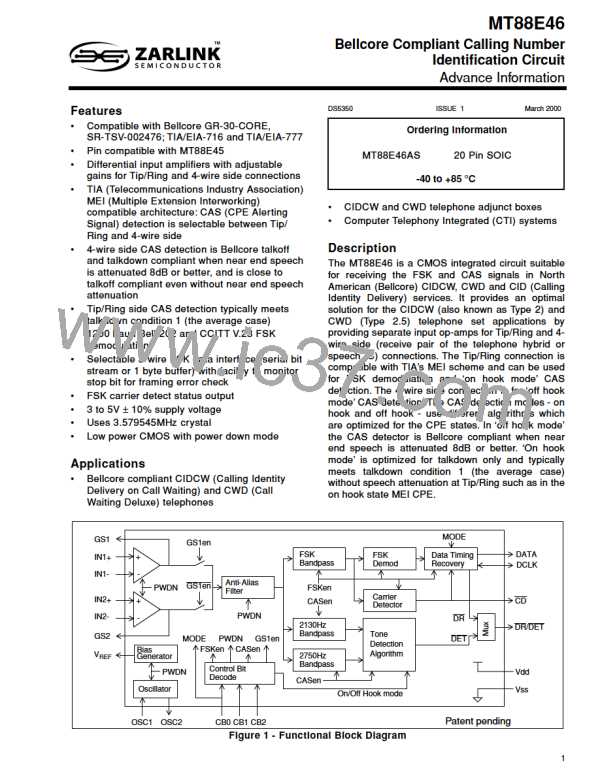Advance Information MT88E46
speech IC receive pair while the CAS level is the
same as on Tip/Ring. Talkoff immunity is also better
because the near end speech is attenuated.
Functional Overview
In the Calling Identity Delivery on Call Waiting
(CIDCW) and Call Waiting Deluxe (CWD) services
offered by North American telephone operating
companies, a dual tone known as CAS (CPE Alerting
Signal) is sent from the central office to notify the
near end CPE, which is already engaged in an
established call, that the central office wishes to
deliver calling identity information of a waited call.
The signalling protocol is specified in Bellcore GR-
30-CORE, the CPE (Customer Premises Equipment)
requirements in SR-TSV-002476.
In the GR-30-CORE issue 1 off hook protocol, the
near end CPE must not ACK if there is a parallel off
hook CPE. Otherwise the ACK will not be detected
reliably at the central office. This restriction is
modified by a protocol known as MEI (Multiple
Extension Interworking) developed by the TIA
(Telecommunications Industry Association) in
conjunction with Bellcore. MEI allows a CPE to ACK
if all off hook CPEs are MEI compatible. MEI is
described in the TIA/EIA-777 standard.
In the GR-30-CORE off hook protocol, the central
office mutes the far end connection (the other end of
the established call) just before CAS is transmitted.
When the near end CPE detects the CAS, it mutes
the handset and checks whether there is any parallel
off hook CPE. If there is no parallel off hook CPE, it
acknowledges CAS reception by sending ACK,
which is a predefined DTMF digit, back to the central
office. When the central office receives ACK, it
transmits the calling party information in 1200 baud
Bell 202 format FSK to the near end CPE which then
typically displays the information to the user.
MEI introduces the concept of the ACK-Sender and
the Backup ACK-Sender.
•
On a per call basis, the ACK-Sender is the first
CPE to go off hook for the call. It retains its
status even if it returned on hook while the line
remains in use. The ACK-Sender must give up
its status if a Type 3 (Analog Display Services
Interface) CPE asserts its ACK-Sender status.
•
The Backup ACK-Sender is the CPE to last
respond to CAS with an ACK and successfully
received FSK data. It retains its status from call
to call but must give up its Backup ACK-Sender
status when another CPE successfully
When CAS is transmitted from the central office,
even though the far end has been muted the near
end user (the end which is to receive the caller ID
information) may be speaking. Therefore, the CAS
must be detected in the presence of near end
speech, noise or music. Failure to detect the CAS
and reply with ACK within a defined interval is known
as ‘talkdown’. Talkdown is undesirable because the
central office will not deliver the calling information,
hence the quality of the CIDCW or CWD service will
be degraded.
completes the CAS-ACK-FSK sequence.
When CAS is sent from the central office, all MEI
compatible off hook CPEs detect CAS and go back
on hook. After the ACK-Sender detected CAS, it
monitors the line voltage. When the line voltage has
returned to the HIGH state (the voltage when the line
is not terminated by any CPE), it goes off hook and
sends the ACK. If there is no ACK-Sender because
the first CPE to go off hook is not MEI compatible,
the Backup ACK-Sender takes over and sends the
ACK. Note that both the ACK-Sender and the
Backup ACK-Sender can be on hook or off hook.
Since CAS can be transmitted anytime during an
established call, the CAS detector is therefore
subjected to speech, noise or music - which can
imitate CAS - from both the near end and the far end
throughout the call. False detection followed by ACK
is known as ‘talkoff’. Talkoff is undesirable because it
annoys the far end user by the near end CPE’s
sending ACK and because the near end CPE is
muted in anticipation of the FSK signal.
Because it may be the ACK-Sender or Backup ACK-
Sender, an MEI compatible on hook state CPE must
be able to detect CAS when the line is in use.
Additionally, the TIA/EIA-777 standard requires an
MEI on hook state CPE to detect CAS during a call
so that it can listen in on the FSK to keep its call log
consistent with the off hook CPEs. However, a CAS
detector connected only to the hybrid / speech IC
cannot detect CAS when the CPE itself is on hook
because either the hybrid / speech IC is not
operational or the signal level is severely attenuated.
Therefore an MEI compatible CPE must be able to
detect CAS from Tip/Ring when the CPE is on hook,
and be able to detect CAS from the hybrid / speech
IC when the CPE is off hook.
Bellcore has specified talkdown and talkoff immunity
performance requirements in SR-TSV-002476. If the
CPE is a telephone, one way to achieve good CAS
speech immunity is to put CAS detection on the
receive pair of the telephone hybrid or speech IC
instead of on Tip and Ring. Compared to a Tip/Ring
connection, talkdown immunity improves because
the near end speech is attenuated on the hybrid /
5

 ZARLINK [ ZARLINK SEMICONDUCTOR INC ]
ZARLINK [ ZARLINK SEMICONDUCTOR INC ]